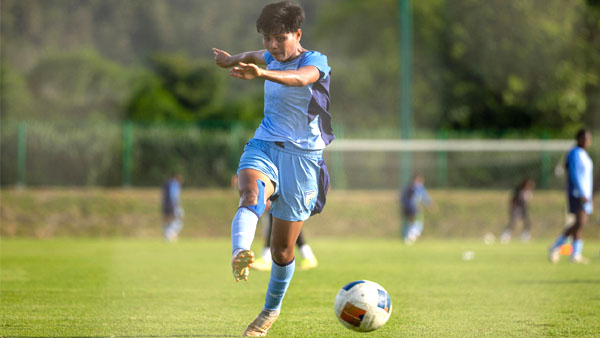The Story of India’s Sportswomen
By Dipak Kurmi
In a nation where cricket often eclipses every other sport and where male athletes command the lion’s share of attention, recognition, and funding, a quiet revolution is unfolding on the margins of stadiums, dusty fields, and social media timelines. For the first time in history, the Indian Women’s National Football Team—fondly known as the Blue Tigresses—has qualified on merit for the AFC Women’s Asian Cup 2026. This milestone, led by the formidable midfielder Sangita Basfore, is not just another sporting accomplishment. It is a seismic moment in Indian sports—one that has, tragically, failed to echo across mainstream consciousness.
If you didn’t see hashtags trending or headlines flashing, you’re not alone. The Blue Tigresses’ qualification didn’t dominate prime-time panels, nor did it earn the applause of ticker tape parades or celebratory campaigns. And yet, their feat is nothing short of historic. The AFC Women’s Asian Cup 2026, scheduled to be held in Australia from March 1–21, doubles as a gateway to the 2027 FIFA Women’s World Cup and the 2028 Los Angeles Olympics. This is not just another tournament—it is India’s golden ticket to elite global football. For the first time, the women’s team is poised not as passive hosts but as active contenders. But their ascent has been met with silence, a silence that speaks volumes about how India perceives its sportswomen.
This isn’t an isolated oversight. It is a pattern—persistent, systemic, and revealing. Indian sportswomen have long carried the nation on their shoulders. From Mary Kom’s powerful punches and PV Sindhu’s thundering smashes to Mirabai Chanu’s Olympic lifts, their victories have lifted national morale and rewritten record books. And yet, their faces don’t adorn billboards, and their voices are rarely sought in brand campaigns.
The contrast is stark and unsettling. Consider Annu Rani, the national record holder in javelin throw, who continues to push the boundaries of the sport while Neeraj Chopra’s every stride is bathed in spotlight. Savita Punia, the indomitable goalkeeper of the Indian women’s hockey team—aptly nicknamed the “Wall of India”—was instrumental in our Olympic semi-final run in Tokyo, but remains largely uncelebrated. Manasi Joshi, the para-badminton world champion and techie-turned-athlete, is a fierce advocate for inclusivity in sports, yet her story is known to only a discerning few.
Why does this disparity persist? The truth lies not only in media neglect but in society’s deep-rooted gender biases. In Shabaash Mithu, a biopic on Indian cricket legend Mithali Raj, a gut-wrenching scene at an airport illustrates this chasm. The women’s cricket team returns after a heroic World Cup performance—bruised but proud—only to be met with silence. Moments later, the men’s team arrives, despite a loss, and the same space erupts with cheers and flashbulbs. This isn’t cinematic license. It’s reality. Indian sports still celebrates male failure more enthusiastically than female success.
Corporate India, too, mirrors this imbalance. According to a KPMG report, over 85% of India’s sports marketing budgets are allocated to men’s cricket alone. Olympic medallists like Lovlina Borgohain and Mirabai Chanu still struggle to land a single endorsement, while male cricketers—sometimes without significant accomplishments—sign multi-crore brand deals with ease. PV Sindhu, India’s most marketable female athlete, reportedly earns less than a fringe player in the IPL. “Brands want reach, not reality,” a former sports agent admitted, highlighting how visibility is still defined by masculine metrics.
The cricket monopoly has drowned out other sports, and worse, other genders. The Women’s Premier League (WPL) was a vital breakthrough, yet it receives only a fraction of the airtime, sponsorship, and public discourse lavished upon the men’s IPL. Social conditioning amplifies this divide. In many Indian households, daughters are told to “sit properly,” avoid rough games, and “stay indoors” after dusk. Boys receive bats; girls are handed dolls. One young sprinter from Haryana summed it up poignantly: “My brother played district matches. I had to fight just to get shoes.”
The resistance doesn’t stop at social norms—it’s institutional. Radhika, a rising tennis player, saw her father socially shamed not for her failure, but for her success. Even today, basic access to facilities, safety during late-night training, or even just moral support is a luxury many female athletes can’t afford. Indian sport is still shackled by an outdated masculinity myth—one that defines strength, aggression, and ambition as inherently male. Women who dare to be fierce and feminine simultaneously confuse a society that doesn’t know how to embrace them. So Sania Mirza’s skirt gets more coverage than her smashes, and Mithali Raj, after a match-winning century, is asked about her “favourite male cricketer.”
The media isn’t immune either. A senior sports editor once confessed, “We’re pushed harder to cover IPL afterparties than a world championship won by a female wrestler.” This confession encapsulates the rot. When the Indian men’s cricket team sneezes, it’s breaking news. When the Indian women’s football team earns qualification for Asia’s top tournament on merit, it’s reduced to a fleeting crawl on the screen.
Still, in the face of this erasure, sportswomen continue to rise. Harmanpreet Kaur, captain of the Indian women’s cricket team, puts it simply: “We’re not asking for fame. Just fairness.” That fairness, increasingly, is being built outside traditional frameworks. Social media has emerged as a democratic battlefield, allowing female athletes to tell their stories unfiltered. They are bypassing the legacy media’s gendered gaze and building communities of support that the mainstream ignores.
The grassroots revolution in Jharkhand is a case in point. Yuwa, founded by US-based Franz Gastler, began with one girl’s dream to play football. Today, it is eastern India’s largest girls’ football movement. It’s not just about sport—it’s a resistance against child marriage, illiteracy, and trafficking. More than 250 girls play regularly, 150+ every day, on village fields, many coached by former Yuwa players. This is what real impact looks like—not in TRP spikes, but in life-changing transformation.
Institutional initiatives like Khelo India and the expansion of the WPL have begun to nudge the needle. Medal winners like Hima Das, Dipa Karmakar, Rani Rampal, and Mithali Raj are finally becoming household names. But recognition must not be reserved for peaks. True change will only arrive when we celebrate consistency, not just gold. When we stop treating women’s sport as charity content and start viewing it as a prime-time product. When we stop waiting for Olympic medals to recognise a woman athlete’s journey and instead invest in that journey from day one.
India’s sportswomen are not waiting for permission. They’re creating their own arenas, their own leagues, and their own legacies. What they need is not tokenism but transformation. Not sympathy but systems. Not post-win accolades but pre-game infrastructure. The Blue Tigresses’ qualification is not just a moment—it is a message. It tells us that the future of Indian sport is not male. It is inclusive. It is diverse. It is undeniable.
It’s time we turn the volume up on their stories. Because if we don’t hear the roar of the Tigresses now, we may not deserve the victory that is surely coming.
(the writer can be reached at dipakkurmiglpltd@gmail.com)




